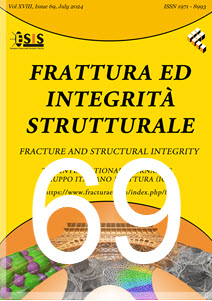Titanium/FRP hybrid sandwich: in-plane flexural behaviour of short beam specimens
DOI:
https://doi.org/10.3221/IGF-ESIS.69.02Keywords:
Fibre reinforced polymer, Titanium, Electron Beam Melting, Sandwich beam, In-plane behaviourAbstract
Adopting novel sandwich structures with FRP (Fibre Reinforced Polymer) skins and a metallic lattice core, both of which have high specific strength and stiffness, is one way to achieve better mechanical performance while remaining lightweight. Flexural stress is a load pattern that frequently occurs in the structural frame components of automobiles; nonetheless, while the in-plane load scheme has scarcely been examined, the out-of-plane load one has. As a result, the former configuration received consideration in this work. Moreover, short beam specimens were taken into account. The mechanical response of specimens with three different kinds of composite materials as skin material was analysed. The skins were made of CFRP (Carbon Fiber Reinforced Polymer), with two different weaving styles, and AFRP (Aramid Fiber Reinforced Polymer). All-titanium specimens were studied, too. Similar maximum loads and maximum displacement at break were recorded for both CFRP and AFRP specimens, while the all-titanium one resulted stronger. In terms of the load-displacement curves, the first section featured an initial linear phase, followed by a minor load drop, likely attributed to the breakage of fibres. The CFRP specimens showed a sharp fracture of the skin fibres, while for the AFRP, a fraying was observed.
Downloads
Downloads
Published
Issue
Section
Categories
License
Copyright (c) 2024 Costanzo Bellini, Rosario Borrelli, Vittorio Di Cocco, Stefania Franchitti, Francesco Iacoviello, Larisa Patricia Mocanu, Luca Sorrentino

This work is licensed under a Creative Commons Attribution 4.0 International License.
Copyright
Authors are allowed to retain both the copyright and the publishing rights of their articles without restrictions.
Open Access Statement
Frattura ed Integrità Strutturale (Fracture and Structural Integrity, F&SI) is an open-access journal which means that all content is freely available without charge to the user or his/her institution. Users are allowed to read, download, copy, distribute, print, search, or link to the full texts of the articles in this journal without asking prior permission from the publisher or the author. This is in accordance with the DOAI definition of open access.
F&SI operates under the Creative Commons Licence Attribution 4.0 International (CC-BY 4.0). This allows to copy and redistribute the material in any medium or format, to remix, transform and build upon the material for any purpose, even commercially, but giving appropriate credit and providing a link to the license and indicating if changes were made.




































